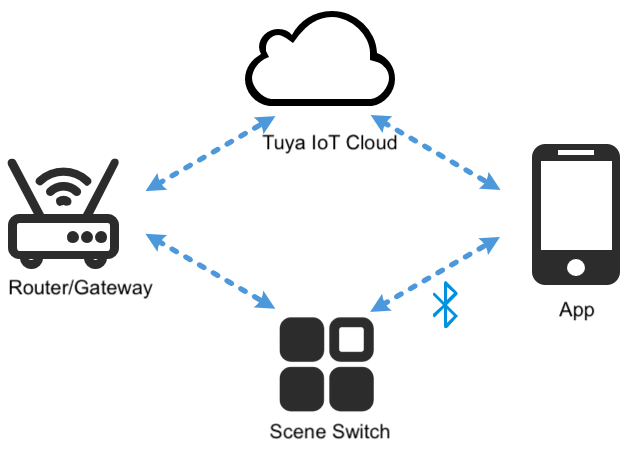Scene Switch
Last Updated on : 2024-06-21 04:24:44download
Application scope
This topic describes tests on the mass production of scene switches. It will help to apply for the Tuya Cloud certification.
Test scope
| Function | Scope |
|---|---|
| Package | Packaging materials, accessories, graphics, and texts. |
| Appearance and structure | The overall appearance and the button structure. |
| Hardware function | The reset button, the power button, and the indicator. |
| Software function | Network management, status synchronization, indicator light display, cloud scene, local scene, cloud automation, and local automation. |
| Special test | Stability test. |
Test environment
The following figure shows the networking architecture for testing the scene switch.

Test guide
Package
- Test purpose: Ensure the integrity of the packaging materials and accessories, and the accuracy of the graphics and texts.
- Scenario: The user unpacks the package for the first time.
- Test method: Take a visual inspection when unpacking.
- Pass standard: The box is intact, the accessories are complete, and the graphics and texts are clear and explicit.
- Possible problems: The box is deformed or damaged, the accessories are incomplete, and the graphics and texts are inconsistent with the actual device.
Appearance and structure
- Test purpose: Ensure the functionality and the appearance completeness of the buttons.
- Scenario: The user experiences the device in daily use.
- Test method: Use the manual operation and visual inspection.
- Pass standard: The button control is functional without any appearance defects.
- Possible problems: The appearance has obvious scratches, and the button is sunken and irresponsive.
Hardware function
- Test purpose: Ensure the functionality and the appearance completeness of the buttons.
- Scenario: The user experiences the device in daily use.
- Test method: Use the manual operation and visual inspection.
- Pass standard: The indicator, the buttons, and other parts are functional.
- Possible problems: The buttons are abnormal.
Network management
- Test purpose: Ensure that the switch is paired.
- Scenario: The scene switch is paired for the first time after purchasing.
- Test method: Trigger the scene switch to enter the pairing mode and pair it with the app.
- Pass standard: The scene switch is successfully paired and controllable online.
- Possible problems: The pairing fails because network problems occur, the app unbinding fails, or the mobile phone is not connected to a 2.4G network.
Status interaction
- Test purpose: Ensure that the scene switch can be locally controlled in real time and the device status is properly reported.
- Scenario: The user checks the status of the scene switch after the scene switch is paired, restarted, or reconnected after the device gets offline.
- Test method: Check the status of the scene switch on the app after the scene switch is paired, restarted, or reconnected after the device gets offline.
- Pass standard: The status is properly updated after the scene switch is paired, restarted, or reconnected after the device gets offline.
- Possible problems: The status is displayed anomaly because network problems occur or the status is not reported by the device.
Indicator
- Test purpose: Ensure that the indicator functions properly.
- Scenario: Check the indicator status after the switch or the socket is paired, powered off, powered on, controlled, or reconnected after the device gets offline.
- Test method: Check the indicator status after the switch or the socket is paired, powered off, powered on, controlled, or reconnected after the device gets offline.
- Pass standard: The device can be paired, restarted, reconnected after it gets offline, and controlled in compliance with the IoT configuration rules.
- Possible problems: The indicator does not change or flicker.
Cloud scene
- Test purpose: Ensure that the cloud scene is triggered as expected.
- Scenario: Perform scene linkage on the app.
- Test method: Associate the app with the device and check the triggering status of the scene.
- Pass standard: The associated device scene is triggered as expected.
- Possible problems: The scene cannot be triggered after disconnection.
Local scene
- Test purpose: Ensure that the local scene is triggered as expected.
- Scenario: Perform scene linkage on the app for the gateway.
- Test method: Associate the app with the sub-device under the gateway, and check the triggering status of the scene.
- Pass standard: The associated device scene is triggered as expected.
- Possible problems: The scene cannot be triggered after the device is disconnected. No response is returned after the scene is triggered multiple times.
Cloud automation
- Test purpose: Ensure that the cloud automation is effectively executed as expected.
- Scenario: Perform scene linkage on the app.
- Test method: Set the environmental conditions on the app and check the execution status.
- Pass standard: After the condition is triggered, the automation is effectively executed.
- Possible problems: The automation function is not executed.
Local automation
- Test purpose: Ensure that the local automation is effectively executed as expected.
- Scenario: Perform scene linkage on the app for the gateway.
- Test method: Set the environmental conditions on the app and check the execution status.
- Pass standard: After the condition is triggered for the gateway, the automation is effectively executed.
- Possible problems: The automation function is not executed after multiple triggering.
Stability
- Test purpose: Ensure the proper functions of the device.
- Scenario: The user uses the device for a long time.
- Test method: Simulate daily usage scenarios with 3 to 10 switches or sockets for seven days . This allows you to monitor the reliability of the device.
- Pass standard: The device stays online for seven days.
- Possible problems: The device cannot be controlled on the app because the device is offline.
Is this page helpful?
YesFeedbackIs this page helpful?
YesFeedback





